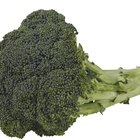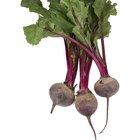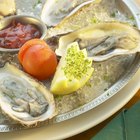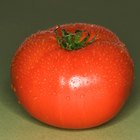
If a recipe calls for you to blanch broccoli, it wants you to briefly submerge it in boiling water. This process isn’t only for vegetables. You may need to blanch fruits and some meats, depending on your recipe. Blanching means to "whiten," but it does so much more when it comes to food.
Method
To blanch a food, bring a large pot of water to a boil. Drop the food in for 10 to 60 seconds, depending on the size and makeup of the food. Small cuts of vegetables need just a brief time while denser proteins, such as chicken breast or sweet breads, take longer. Blanching is often followed by shocking, meaning you immediately plunge the boiled item into ice-cold water to stop the cooking process.
Vegetables
Blanching vegetables can make your vegetable platter pop. Dropping vegetables, such as snap peas, green beans, cauliflower and zucchini into a shot of boiling water crisps their outsides and makes their colors more vibrant. To ensure you don’t overcook the vegetables into a mushy mass, shock them immediately after blanching. If you have an abundance of vegetables from the farmer’s market, you might blanch and shock them before freezing them. A recipe may also call for you to blanch strong-tasting vegetables, such as cabbage or onions, before adding them to the primary dish to create more subtle, pleasing flavors.
Fruits and Nuts
Blanching certain types of fruit makes peeling a snap. For example, carefully draw a small crosshatch at the base of a peach -- just piercing the skin. Drop the whole fruit into a pot of boiling water for a minute or so and remove it with a slotted spoon. Shock and then peel -- the skin should come off easily. You can use the same technique to peel tomatoes, plums and nectarines. Many nuts are blanched before hitting the market to remove their outer skin. Almonds, hazelnuts and pistachios are usually blanched before being used in desserts.
Proteins
Certain types of meats and fish, including organ meats, chicken breast and some seafood, benefit from blanching. You blanch organ meats to remove some of musty taste and begin the breakdown of the dense connective tissue that can make offal chewy. Small chunks of chicken, shrimp or ham may be blanched and then flash chilled to be served on a cold salad. Restaurants often blanch chicken or shrimp before adding it to soup just before service -- if they cooked it in the soup and held it over heat for a long time, the meat would be overcooked. Blanching also precooks meats for a stir fry or shabu shabu. Do not shock proteins in cold water as this will waterlog the meat and make it unpleasant to eat.
Related Articles

What Vegetables Have Citric Acid?

How to Wash Wax Off of Vegetables

How to Roast Beets for Canning or ...

Description of Spanish Foods

African Food Facts

The Best Way to Peel Grapes

How to Freeze Fresh Beets

If Chicken Smells Bad Can You Still ...

How to Blanch Frozen Shrimp
Can You Freeze Shish Kabobs?
How to Boil Potatoes So They Can Be ...

Symptoms of Food Poisoning With Oysters

Traditional French Easter Food

How to Blanch, Peel, & Freeze Whole ...
How Long do Leftovers Last?

How to Use Eggplant in Soup

A List of Foods Containing Microbes

Inexpensive Finger Foods for a Wedding ...

How to Cook Crawfish

How to Get Meat to Stay Moist When ...
References
Writer Bio
Andrea Cespedes is a professionally trained chef who has focused studies in nutrition. With more than 20 years of experience in the fitness industry, she coaches cycling and running and teaches Pilates and yoga. She is an American Council on Exercise-certified personal trainer, RYT-200 and has degrees from Princeton and Columbia University.
Photo Credits
Hemera Technologies/AbleStock.com/Getty Images